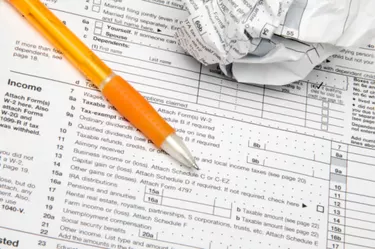
The bulk of most taxpayer taxable income is reported to the Internal Revenue Service before taxes are due. In many cases, such as with wages, employers withhold income taxes from the earnings, but other types of income that aren't subject to payroll taxes are untaxed by the end of the year. Although you received money that wasn't taxed when you received it, be it as an independent contractor, as unemployment insurance benefits or gambling winnings, you're responsible for paying taxes on that money.
Step 1
Determine if the untaxed money is taxable income. Most money you receive throughout the year is subject to taxes, although Supplemental Security Income, workers' compensation benefits, welfare benefits, child support payments and gifts aren't subject to income tax assessment.
Video of the Day
Step 2
Report investment earnings on Line 8a through 9b on your Form 1040. Only include income paid to you this year, such as interest and dividend payments. The increase in value of investments isn't taxable until you sell the investment property. You should receive a 1099-INT form for each taxable investment return.
Step 3
Report alimony using Line 11 of your 1040. Report the entire amount of alimony payment.
Step 4
Submit a Schedule C to report any self-employment earnings. Use information clients provide on 1099-MISC forms detailing their payments to you, as well as other nominal income or billed income that isn't accompanied by a 1099-MISC. Transfer the final gains from Schedule C to Line 13 of your 1040.
Step 5
Report IRA distribution and pension amounts on lines 15a through 16b. Depending upon the structure of your retirement accounts, these benefits may be taxable, or you may have paid taxes on the income before investing the money.
Step 6
Submit Schedule E to report income earned from real estate rental income as well as income generated from partnerships and S-corporations. Transfer the bottom line number from this schedule to Line 17 on your 1040.
Step 7
Submit Schedule D to report capital gains. Capital gains are the difference between the investment price of a property such as real estate, stocks or collectible art and the price at which you sold it. Transfer information from Schedule D to line 13 of your 1040.
Tip
To avoid a large year-end tax bill, submit estimated income tax payments quarterly with Form 1040-ES.
Warning
The IRS receives a copy of each 1099 you receive and expects you to acocunt for that income on your 1040. If you fail to report 1099 income, expect to receive a bill for the additional tax due, interest charges and penalties.
Video of the Day